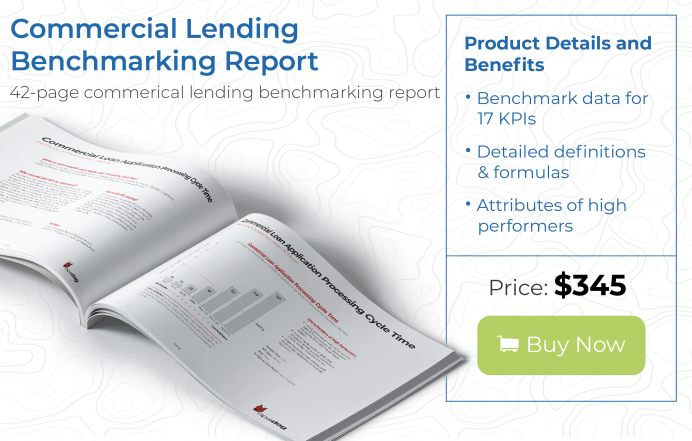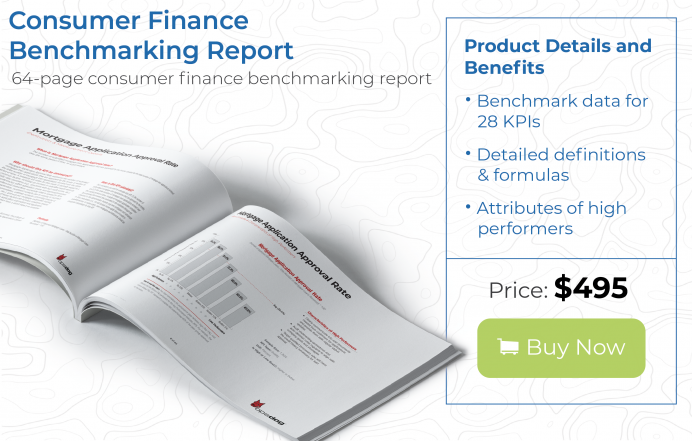Banks use net interest margin—the yield between the interest they pay to depositors and the amount of interest they receive from commercial and consumer loans—as one indicator of profitability and growth. And while interest rates are largely out of banks’ control since they are tied to the federal funds rate, lenders can improve lending efficiency to positively impact net interest margins.
What are Performance Metrics for Commercial and Consumer Lending?
For consumer loans such as mortgages and automobiles, lenders evaluate the personal financial health of the borrower(s) when deciding whether to approve or decline a loan. Underwriting is typically faster, and borrowers need to present less documents than business borrowers.
Commercial loans tend to be for higher loan amounts than consumer loans, plus they are often much more complex. Commercial loan underwriting analyzes the entire business, properties, and equipment and takes into account factors such as liquidity, profitability, and growth potential. Lenders also often compare the borrower’s business against its peers to evaluate financial health.
But even with these differences, commercial and consumer loans share common profitability metrics. For example, a loan that takes longer to close increases costs and impacts profitability, regardless of the type of loan.
While banks often use the same calculations for commercial and consumer loans, the results will be different. Since they are less complex, consumer loans should take lenders less time to process, underwrite, and close and processors should be able to handle a higher volume of consumer loan applications than commercial loan applications.
The Benefits of Using Metrics to Measure Loan Performance
Key performance indicators (KPIs), key risk indicators (KRIs), metrics, and benchmarks can pinpoint the areas for improvement that will deliver the biggest ROI and impact on profitability. Establish baseline metrics and compare this data over time to make strategic decisions on everything from loan employee training to hiring additional staff to changing loan application workflows to investing in new technologies.
However, it’s important to attack the root cause problem. If you discover that it takes your bank longer than a peer lender to close consumer loans, the knee-jerk reaction may be to hire more processors. Instead of throwing more bodies at the problem, look for redundant or manual tasks that are slowing down the process. Are borrowers completely filling out the loan applications? Give loan originators a checklist to follow to catch missing information before passing the application along to processors.
Perhaps perform regular audits of the application process to find places to reduce the number of touchpoints. Create standardized and validated data inputs to minimize input errors on loan applications.
Or, if the cost to originate loans is higher than industry benchmarks, look at improving your digital offerings to encourage borrowers to apply for loans on less costly online and mobile channels.
Loan Officer Performance Metric Examples
Here are five commonly used performance metrics for both commercial and consumer loans:
Loan Performance Metric #1: Commercial Loans Outstanding per Loan Servicing Employee
The productivity of the loan servicing function has a direct impact on lender profitability. If fewer servicing employees can handle more loans, operational costs go down. Lenders that have a low outstanding loan balance per employee could be overstaffed or employees may just need better training. But if staffing levels seem appropriate—and employees are skilled—the problem may be the servicing process itself. Look for manual tasks, errors, and missing documents as likely culprits.
To calculate, divide the dollar amount of all unpaid, interest-bearing commercial loan balances by the number of servicing employees. Include all employees who work with customers, including call center employees and those working in escrow or collateral management and investor relations. Don’t include non-performing loans.
Loan Performance Metric #2: Consumer Loan Applications per Consumer Loan Processing Employee
Loan processing employees include anyone who prepares loan packages, checks documents, coordinates with third parties, and performs pre- and post-close loan documentation reviews. This metrics measures efficiency: the goal is to have the fewest number of loan processing employees as possible without impacting loan quality.
Divide the number of consumer loan applications processed by the number of loan processing employees. Don’t include loan officers, appraiser, or inspectors.
Loan Performance Metric #3: Commercial Loan Application Processing Cycle Time
Even though commercial loans tend to be more complex than consumer loans, lenders are under pressure to approve or decline these loans as quickly as possible to cut down on costs and improve business customer satisfaction. This metric measures the number of days it takes from the time the customer submits the application until it’s sent to underwriting.
To calculate, divide the number of calendar days needed to process commercial loan applications by the number of commercial loans received.
Loan Performance Metric #4: Consumer Loans Closed per Consumer Lending Employee
To keep costs in check, lenders want the fewest number of employees yet still maintain high loan production levels. If the number of loans closed per lending employee is low, evaluate both the skill of the employees as well as whether there are holdups in the process. For example, employees may waste time following up with borrowers if borrowers don’t complete applications properly or send the required documentation.
Divide the total number of consumer loans closed by the number of consumer lending employees. Consumer lending employees include loan officers, loan processors, underwriters, and closers.
Loan Performance Metric #5: Percentage of Commercial Loans Extended
Having to restructure commercial loans because the loans are troubled has a negative impact on the amount of capital the lender has for future loans. But, on the flip side, loan extensions mean that the lender will receive more in interest payments. As a general rule, the lower the percentage of restructured loans, the better.
To calculate the percentage of commercial loans with an extended maturity date, divide the dollar amount of restructured commercial loans by the total dollar amount of all outstanding commercial loans, as a percentage.
Final Thoughts
Commercial and consumer lending has many moving parts, any of which can impact net interest margin and ultimately profitability. Use key performance indicators (KPIs), key risk indicators (KRIs), metrics, and benchmarks to identify which parts are causing the most pain and then identify and correct the root causes.
For a full list of lending and other related banking performance metrics, download our Banking Key Performance Indicator Encyclopedia here.
If you require additional assistance in developing metrics to benchmark again then you may find our Commercial Lending Benchmarking Report helpful. For even more information on our Benchmarking Research and business intelligence implementation services, contact us here. OpsDog can help your insurance company build a benchmark plan and provide you with presentation-ready, high-quality deliverables.





